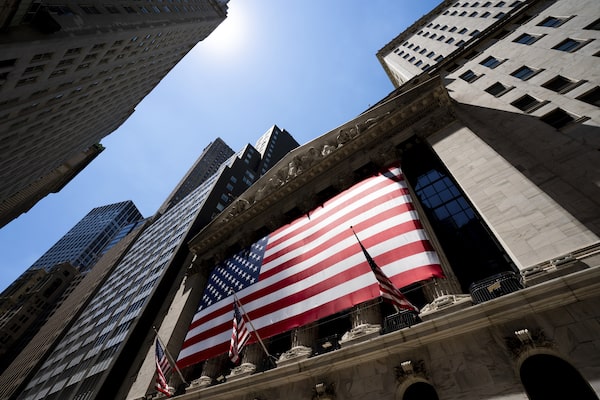
The New York Stock Exchange on June 29, 2022, in New York.Julia Nikhinson/The Associated Press
Ten months into the U.S. stock market’s remarkable rebound, a rally that has propelled the S&P 500 to within spitting distance of its record high, invincibility is in the air.
A year ago, the question wasn’t whether the U.S. – and Canada – would have recessions, but rather when they would hit. And because central banks were turning aggressive to combat inflation, the ultra-low interest rates that had driven stock market returns over the prior decade were reversing rapidly.
To buy stocks, and particularly U.S. stocks, in the face of all that seemed ludicrous. But those who did are the ones laughing now. After slumping 19 per cent and 33 per cent, respectively in 2022, the S&P 500 and the Nasdaq Composite Index have trounced other Western markets this year.
At this point in the rally, there is a natural inclination for investors to feel untouchable – and the nascent artificial intelligence boom, coupled with encouraging U.S. unemployment numbers, like those released on Friday, only re-enforce that mindset.
“We’re in that phase of the market when folks aren’t worried about anything,” says Andrew McCreath, chief executive of Canadian hedge fund Forge First Asset Management.
But to keep pumping the U.S. stock market at this stage of the rally requires flirting with denial. While the U.S. economy has been encouraging, there are storm clouds that can’t be ignored, including: China’s economic woes; an inverted yield curve that typically foreshadows a recession; and CEOs, not economists, warning that a slowdown is already unfolding. Some have gone so far as to say a mild recession is here, according to their revenues, but the general public doesn’t know it yet.
That doesn’t mean the U.S. market is going to crash soon. The pandemic boom was a reminder that investors can convince themselves of just about anything. Even though central banks have hiked benchmark interest rates aggressively, the U.S. government (and Ottawa) is still spending like crazy, which ultimately injects liquidity into the financial system. “We have to accept the fact that this cycle is very different from others because of the gargantuan fiscal stimulus,” Mr. McCreath said.
Even if the much-vaunted soft landing materializes, it could force a rethink. In this dream scenario, economic growth is still muted, and that alone could force investors to question whether frothy valuations – the S&P 500 is currently trading around 20 times earnings and the Nasdaq is trading around 33 times earnings – make much sense. All it takes is for a few investors to cash in their gains for the rally to reverse.
CEOs are already expressing caution. In April, Tracy Robinson, the chief executive of Canadian National Railway, which hauls goods and commodities across North America, cautioned a downturn was materializing. “Our current volumes reflect that we are in a mild recession,” she told analysts on a conference call. “We’re uncertain about how deep, or how long it will go on. But what we’re modelling is negative North American industrial production for the full year.”
Last week, CN reported its latest quarterly earnings and pushed out its expectations for an economic recovery into 2024, telling analysts their clients have warned that shipments would remain weak for the next two quarters.
Similar comments were made last week by Duncan Wanblad, the CEO of miner Anglo American, which warned that an “enormous amount of economic pressure” was weighing on the prices of commodities such as copper, metallurgical coal used for steelmaking and iron ore – despite all the hype around the need for certain metals, such as copper, to fuel the green transition. (Copper is required in electric car batteries, for example.)
China’s middling economy is a key factor in this malaise. After multiple years of hard lockdowns to suppress COVID-19, something is awry in the country’s reopening, with youth unemployment spiking and the property sector taking a beating. For years, China’s insatiable thirst for metals and energy boosted commodity prices, but the country’s economic recovery is now so dicey that there are fears China could face years of deflation.
Then there are financial markets, some of which are screaming caution even as stocks soar. The U.S. government yield curve, which tracks annual yields for government bonds ranging from three-month maturities to 30-year maturities, is inverted, because short-term bonds pay close the central bank rate. Currently, three-month U.S. debt pays 5.4 per cent annualized while 10-year and 30-year bonds pay 4.2 per cent and 4.3 per cent, respectively.) Canada’s yield curve is also inverted.
In every single one of the last seven recessions, the yield curve has inverted before the economy started to shrink. Every single one. But investors tend to forget that the economic slowdown takes time to unfold. There is always a delay between the start of the central bank tightening cycle and the start of the recession. Famously, in 2006, it took 18 months from the start of the yield curve inversion for the Great Recession to hit.
“The historical record shows that, without exception, the economy slows down and does so precipitously in the two years that follow the END of the Fed tightening cycle,” economist David Rosenberg wrote in a note to clients this week.